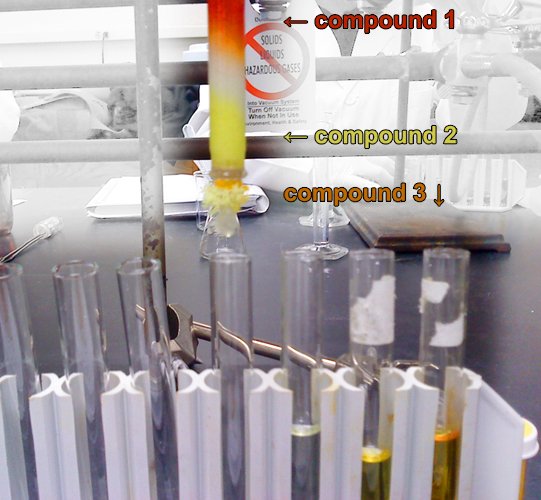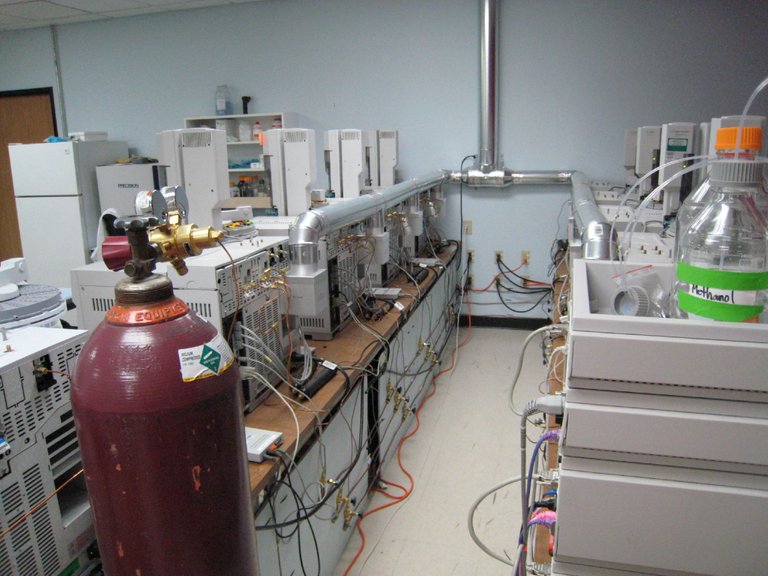Separation and Purification - Chromatography Explained
You wrote a long note at a conference with a black pen and you were happy you have learned something new (possibly what I am about to share with you today if you are just hearing it for the first time), but on your way home, there was a heavy drop, and the rain wet the book as well as yourself. you decided to take care of yourself first and ensure you are properly dry since health is wealth, and the only way you can increase your intellectual wealth is when you are healthy but then when you decided to check the book in a couple of days, you realize that instead of having the black ink on the paper, you saw a mixture of red, green, somehow violet. The smudging of the black ink will display the other colors that were joined to make up the black ink. This is known as paper chromatography in its basic form.
Chromatography involves the separation of a mixture via solid or liquid until they have their separate and different compounds or parts. Varying from Thin Layer Chromatography, Gas Chromatography, Ion Exchange Chromatography, and so on, they all rely on two phases which are the stationary phase and the mobile phase. let me quickly use Paper chromatography in this post, I will be going into other chromatographies after this.
With paper chromatography, the stationary phase is the paper. With paper chromatography, the ink spot is located, then a beaker will contain a mobile phase which is usually a solvent in the case of paper chromatography. The solvent is poured on the ink spot but preventing it from bleeding. When the paper is deep into the solvent the solvent travels up through the paper lining taking the ink from the spot to other parts of the paper. This will lead to other spots being located depending on the number of compounds that make up the mixture and Over time, there will be an increase in the different ink distances. The one that travels farther is attracted by the solvent which is the mobile phase while the one that didn't go far away is attracted to the stationary phase which is paper. The separation method of paper chromatography is based on polarity.
Let's pick Thin Layer Chromatography which is used in the chemistry lab very well. With Thin Layer Chromatography, there is also a mobile and a stationary phase. With Thin layer chromatography, the stationary phase is usually a plate or a glass slide coated with silica gel. The plate or the glass slide is not the stationary phase, the silica gel is the stationary phase. A spotter can be used to make a sport on the silica gel. The mobile phase is usually done in the lab in a developing chamber and this is going to be solvent in a low amount so as to prevent complete submerging of the stationary phase. The TLC plate is then inserted into the chamber and the chamber is closed. The solvent in the mobile phase will travel through the plate through capillary action. When it has to do with Thin Layer Chromatography, a UV light/lamp is used to identify the compounds. Aromatic compounds will show in fluoresce. The total number of compounds will show on the plate. The stationary phase is polar and whatever compound doesn't move away or far from the silica gel is polar while compounds that move far away are non-polar compounds.

commons.wikimedia.org
Column Chromatography is another type of chromatography that we will be looking at. It is useful in pharma companies for purification. In Column chromatography, the silica gel or any other compound inside the column is the stationary phase while the solvent poured into it is the mobile phase. The column would be filled with filtration material, and there is a stopcock at the tip of the column. Silica is then added into the column and it would fill almost all the column then the solvent is poured into the column. When the solvent is added, it should go down the column, and as its precedes, there will be a separation between the bands of different compounds which will travel down the column at different speeds based on polarity. As they come out of the column, the separate bands are collected separately.
Gas Chromatography is a slow process used to separate compounds of different boiling points. The liquid sample which is vaporized into gas is injected, then a mobile phase which is an inert gas. The liquid mixes with the inert gas and then the mixture starts to release its gases at different boiling points and the gases are released at different boiling points. The liquid is the stationary phase for this chromatography.
With Size exchange chromatography, the stationary phase is made up of beads that have holes in the middle allowing tiny compounds to be filtered through the holes in the beads while larger compounds have to go around the beads. allowing smaller compounds to come out faster while larger compounds take a longer time. This chromatography is dependent on size.
Ion exchange chromatography has to do with separating proteins, peptide, nucleic acids, polynucleotides and so on. The separation as usual will include the stationary and the mobile phases. The stationary phase is referred to as the Ion exchanger as it has both the cation exchanger and the anion exchanger. The mobile phase is of Agarose gel beads. This chromatography deals with binding affinity.
With this, I hope you understand chromatography which is a process of filtration and purification.
Citation
- https://www.ncbi.nlm.nih.gov/pmc/articles/PMC5206469/#main-content
- https://chem.libretexts.org/Bookshelves/Analytical_Chemistry
- https://www.chemguide.co.uk/analysis/chromatography/paper.html
- https://chem.libretexts.org/Bookshelves/Analytical_Chemistry
- https://www.studysmarter.co.uk/explanations/chemistry/organic-chemistry/column-chromatography/
- https://chem.libretexts.org/Courses/University_of_Arkansas_Little_Rock

Thanks for your contribution to the STEMsocial community. Feel free to join us on discord to get to know the rest of us!
Please consider delegating to the @stemsocial account (85% of the curation rewards are returned).
Thanks for including @stemsocial as a beneficiary, which gives you stronger support.
@elity-sitio this reminded me of my thesis days, I did paper and column chromatography then.